International Journal of Information Technology and Computer Science @ijitcs
Статьи журнала - International Journal of Information Technology and Computer Science
Все статьи: 1254
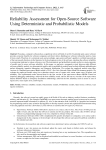
Reliability Assessment for Open-Source Software Using Deterministic and Probabilistic Models
Статья научная
Nowadays, computer software plays a significant role in all fields of our life. Essentially open-source software provides economic benefits for software companies such that it allows building new software without the need to create it from scratch. Therefore, it is extremely used, and accordingly, open-source software’s quality is a critical issue and one of the top research directions in the literature. In the development cycles of the software, checking the software reliability is an important indicator to release software or not. The deterministic and probabilistic models are the two main categories of models used to assess software reliability. In this paper, we perform a comparative study between eight different software reliability models: two deterministic models, and six probabilistic models based on three different methodologies: perfect debugging, imperfect debugging, and Gompertz distribution. We evaluate the employed models using three versions of a standard open-source dataset which is GNU’s Not Unix Network Object Model Environment projects. We evaluate the employed models using four evaluation criteria: sum of square error, mean square error, R-square, and reliability. The experimental results showed that for the first version of the open-source dataset SRGM-4 based on imperfect debugging methodology achieved the best reliability result, and for the last two versions of the open-source dataset SRGM-6 based on Gompertz distribution methodology achieved the best reliability result in terms of sum of square error, mean square error, and R-square.
Бесплатно
Reliability Evaluation Metrics for Internet of Things, Car Tracking System: A Review
Статья научная
As technology continues to advance, the need to create benchmark or standards for systems becomes a necessity so as to ensure that these new advanced systems functions at its maximum capacity over a long period of time without any failure, fault or errors occurring. The internet of things technology promises a broad range of exciting products and services, with car tracking technology as part of the broad range of technological concept under the internet of things paradigm. The car tracking technology involves deploying some basic internet of things components into the tracking of important transportation component; the basic principle behind any technological concept involves delivery of high quality product that conforms to specifications. In this paper, the concept and technological description about the internet of things is discussed with emphasis on the principal functional component, this is to enable a broaden conceptualization about car tracking technology because it needs to function correctly, at all time. The concept of reliability engineering is also discussed in respect to an important quality factor, which entails that systems must function correctly without fault, failure or errors, it provides benchmark, principles, or standards in which the internet of things system must possess for an increased quality assurance.
Бесплатно
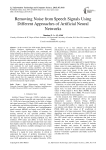
Removing Noise from Speech Signals Using Different Approaches of Artificial Neural Networks
Статья научная
In this research, four ANN models: Function Fitting (FitNet), Nonlinear AutoRegressive (NARX), Recurrent (RNNs), and Cascaded-ForwardNet were constructed and trained separately to become a filter to remove noise from any speech signal. Each model consists of input, hidden and output layers. Two neurons in the input layer that represent speech signal and its associated noise. The output layer includes one neuron that represent the enhanced signal after removing noise. The four models were trained separately on stereo (noisy and clean) audio signals to produce the clean signal. Experiments were conducted for each model separately with different: architecture; optimization training algorithms; and learning parameters to identify model with best results of removing noise from speech signal. From experiments, best results were obtained from FitNet and NARAX models respectively. TrainLM is the best training algorithm in this case. Finally, the results showed that the suggested architecture of the four models have filtering ability to remove noise form both trained and not trained speech signals samples.
Бесплатно
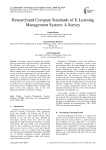
Research and Compare Standards of E-Learning Management System: A Survey
Статья научная
Nowadays, using of e-learning has a special place in organizations and universities. Understanding the efficiency and effectiveness of this type of education, scientific and professional assemblies try to provide effective tools and strategies to operate this kind of training better. E-Learning management system as one of the basic requirements of the system plays a special role in this field. Therefore all companies are looking for a system that meets their needs in the field of e-learning. Standards of content and structure of e-learning must be set so that access to possibilities such as content reuse or gathering or discriminating subject from various sources at different times is possible. This paper reviews and compares some of the most important standards in the field of e-learning.
Бесплатно
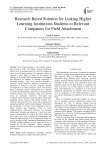
Статья научная
Work-based learning is what equips students with practical skills. All higher learning institutions (HLIs) have a specified period of time for students to carry out field based practices in companies which are relevant to their fields of study. As the number of students in Tanzanian HLIs become larger, coordination and allocation of students to relevant companies is becoming tougher. This study therefore intended to examine a better method to facilitate coordination and allocation of students to relevant companies through development of an online computer system. The research study to determine systems’ requirements was conducted in Arusha and Kilimanjaro regions by involving 62 HLI students, 3 HLIs and 5 companies. Data were collected using key informant interviews, observation and workshop. Both informative and descriptive information regarding current practices and desired features were collected and analyzed. It was found that, a platform for registering students’ profiles and companies’ information has advantages to all three main stakeholders who are HLIs, students and companies. Prior to actual implementation, collaborative prototype was designed using pencil software and shared to 5 users from each group of stakeholders to evaluate the tasks. Responses from users were used to refine the requirements and design the final prototype. The final prototype design was used to develop a Field Attachment Management System (FAMS). FAMS indicated to have improved access of students to relevant companies, reports generation, students’ assessment and follow-up conducted by HLIs to their students.
Бесплатно
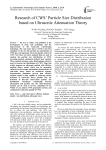
Research of CWS’ Particle Size Distribution based on Ultrasonic Attenuation Theory
Статья научная
The key to reduce coal pollution is the development of clean coal technology and the improvement of the backward coal-burning technology. The coal water slurry (CWS) is the first substitute of the oil. The particle size distribution of CWS plays an important role in the quality control of CWS. Now there are three methods that are used to analysis the particle size distribution of CWS, screening method, settlement method, laser method. These methods produce some disadvantages when be used to forecast the distribution of CWS. Thus, this article proposes an ultrasonic method with effective medium theory model which can be accurately reflected in the acoustic attenuation characteristics of coal-water slurry based on structural average. Experimental simulation proved that effective medium model is fully capable of achieving on-line detection of coal-water slurry particle size, for detection of fine-and coarse-sized particle size distribution. Non-linear relationship between attenuation and particle size, the three-frequency method can be used to inverse calculation of its. Which we can achieve CWS granularity on-line, and continuously control the quality of CWS.
Бесплатно
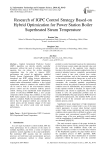
Статья научная
Implicit Generalized Predictive Control (IGPC) algorithm can directly identify controller parameters without the need of solving Diophantine equation, thus can reduce the on-line algorithm computation time. In order to improve IGPC performance and extend its application, modified Particle Swarm Optimization (PSO) algorithm is introduced into IGPC rolling horizon optimization, combined with general IGPC gradient optimization method under unconstrained condition, a new hybrid optimization method is obtained, this modified IGPC can be used to both of the non-constraint industry process control and the constraint industry process control. Aiming at the superheated steam temperature control of sub-critical 600MW boiler, a new cascade compound control strategy that combines an outer loop IGPC master adjuster and an inner loop PID auxiliary adjuster is adopted. Finally the simulation results have shown that the proposed method can constrain the control action, prevent dramatic change of the input signal, thus can achieve good static and dynamic performances.
Бесплатно
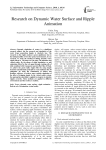
Research on Dynamic Water Surface and Ripple Animation
Статья научная
Dynamic simulation of waters is a significant research subject, but the research and simulation of the water drops generating ripples is relatively less. The research on the ripples motion is great significance due to the indispensability of it in the special environments. In our research, we study the method of adding dynamic water ripple effects in 2D image on Web page, 3D animation and virtual reality. By the means of shape simulation, we add animation effects for the web page through creating cells of table combined with transparent special effect files of Flash. we achieve the good reality ripple effect by using simple dynamics and kinematic principle to create models in the 3D animation. By using the combination of 3dMax and Realflow software, we achieve more realistic simulation of the effect of dripping ripple. In the virtual reality system, the appropriate algorithm is applied in program to simulate ripples correctly. These methods are applied to different environments and the results are realistic.
Бесплатно
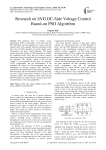
Research on SVG DC-Side Voltage Control Based-on PSO Algorithm
Статья научная
The operation flow of particle swarm optimization (PSO) is presented, at the same time the PSO algorithm and GA algorithm are used to find the optimal value of the standard function, simulation results show that the PSO algorithm has better global search performance and faster search efficiency. The inertia weight decreasing strategy of PSO algorithm is studied, the simulation results show that the concave function decreasing strategy can accelerate the convergence rate of the algorithm. The stability control of the DC-side voltage is very important for the static var generator (SVG) compensation, but the disadvantages of the traditional PI control are fixed parameters and poor adaptability of dynamic response, PSO algorithm is introduced to the optimization of PI parameters, so online PSO-PI control and off-line PSO-PI control are obtained, the SVG voltage loop transfer function is used as the controlled object. The simulation results show that the PSO-PI control can satisfy the time varying system of the controlled object with strong adaptability.
Бесплатно
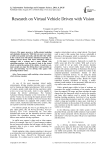
Research on Virtual Vehicle Driven with Vision
Статья научная
This paper presents a traffic-oriented modeling and simulation framework. With this tool, users can create a traffic scene quickly and easily, and then drive the vehicle in the created scene with physics simulated. Especially, the vehicle could be driven with vision technology, which is equipped with a webcam and a paper printed with controlling markers. And the paper is used as the virtual wheel to control the motion of the vehicle. At such low cost, many people can enjoy the driving fun; it also provides an easy and interesting way for driving video games with promising business values.
Бесплатно
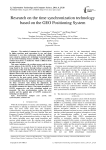
Research on the time synchronization technology based on the GEO Positioning System
Статья научная
The method of common-view is characterized by higher precision, good convenience in use, and cheap instrument. A new time synchronous method for multiple users system by common-view technology is presented based on the GEO Positioning System (GEOPS). And the GEOPS common-view theory is studied for which is different from the other GNSS system. This paper introduces the working process and the time service pattern of the GEOPS. In the GEOPS, the pseudo-range found by the receiver through testing is actually the measurement of the whole link from the main control station and through the satellite to the receiver. Due to the different distances between the main control station and each satellite, this measurement has to be done using the upload delay correction by the main control station. The upload delay adopts a polynomial model and the polynomial parameters are demodulated from the navigation message to calculate the delay correction value during the adjustment. In accordance with these characteristics of GEOPS, we propose the GEOPS common-view theory. The format parameters of GEOPS common-view and data calculating method are presented. The time synchronization system, the error analysis and the applied plan of GEOPS common-view technology are introduced
Бесплатно
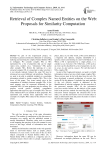
Retrieval of Complex Named Entities on the Web: Proposals for Similarity Computation
Статья научная
As part of the Cognisearch project, we developed a general architecture dedicated to extracting, indexing and searching for complex Named Entities (NEs) in webpages. We consider complex NEs as NEs represented by a list of properties that can be single values (text, number, etc.), "elementary" NEs and/or other complex NEs. Before the indexing of a new extracted complex NE, it is important to make sure that it is not already indexed. Indeed, the same NE may be referenced on several different web platforms. Therefore, we need to be able to establish similarity to consolidate information related to similar complex NEs. This is the focus of this paper. Two issues mainly arise in the computation of similarity between complex NEs: (i) the same property may be expressed differently in the compared NEs; (ii) some properties may be missing. We propose several generic similarity computation approaches that target any type of complex NEs. The two issues outlined above are tackled in these proposals. We experiment and evaluate these approaches with two examples of complex NEs related to the domain of social events.
Бесплатно
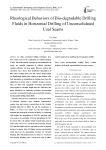
Статья научная
In China, horizontal drilling techniques have been widely used in the exploration of coalbed methane (CBM). The drill-in fluids, especially in unconsolidated coal seams, are typically comprised of cellulose polymers, xanthan polymers and guar gums. However, testing and experience have shown that insufficient degradation of filter cakes resulting from even this “clean” drill-in fluids can significantly impede flow capacity at the wellbore wall. Past approaches to minimizing the damage have been the application of strong acids or oxidative breakers systems. They are often only marginally successful, particularly when applied in extended length intervals. Therefore, this paper introduced an engineered technique incorporating non-toxic, environment friendly and economically attractive bio-degradable drilling fluids (BDF). Extensive lab tests were conducted to evaluate the effects of substrate (polymer) type, substrate concentration, enzyme type and enzyme concentration on the viscosity breaking behaviors of BDFs. We got the conclusions as follows. (1) Power Law model was the best model to matching the rheological properties of BDFs; (2) Compared with konjak, the degradations of Na-CMC and guar gum were easier to be controlled; (3) In the degradation of CMC by enzyme SE-1, the optimal weight concentration ratio of CMC to SE-1 was 3 to 1; (4) Of the three enzymes, enzyme SE-2 had the highest activity and could be used to degrade polymer in shorter time; (5) Higher enzyme concentration could speed up the degradation reaction; (6) Viscosity breaking times fluctuating from 13.5 hours to 74.5 hours and viscosity breaking ratios varying from 20% to 100% could be achieved by modifying the formulations of BDFs.
Бесплатно
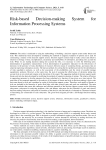
Risk-based Decision-making System for Information Processing Systems
Статья научная
The article is dedicated to using the methodology of building a decision support system under threats and risks. This method has been developed by modifying the methods of targeted evaluation of options and is used for constructing a scheme of the decision support system. Decision support systems help to make correct and effective solution to shortage of time, incompleteness, uncertainty and unreliability of information, and taking into account the risks. When we are making decisions taking into account the risks, it is necessary to solve the following tasks: determination of quantitative characteristics of risk; determination of quantitative indicators for the effectiveness of decisions in the presence of risks; distribution of resources between means of countering threats, and means that are aimed at improving information security. The known methods for solving the first problem provide for the identification of risks (qualitative analysis), as well as the assessment of the probabilities and the extent of possible damage (quantitative analysis). However, at the same time, the task of assessing the effectiveness of decisions taking into account risks is not solved and remains at the discretion of the expert. The suggesting method of decision support under threats and risks has been developed by modifying the methods of targeted evaluation of options. The relative efficiency in supporting measures to develop measures has been calculated as a function of time given on a time interval. The main idea of the proposed approach to the analysis of the impact of threats and risks in decision-making is that events that cause threats or risks are considered as a part of the decision support system. Therefore, such models of threats or risks are included in the hierarchy of goals, their links with other system's parts and goals are established. The main functional modules that ensure the continuous and efficient operation of the decision support system are the following subsystems: subsystem for analysing problems, risks and threats; subsystem for the formation of goals and criteria; decision-making subsystem; subsystem of formation of the decisive rule and analysis of alternatives. Structural schemes of functioning are constructed for each subsystem. The given block diagram provides a full-fledged decision-making process.
Бесплатно
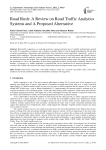
Road Rush: A Review on Road Traffic Analytics Systems and A Proposed Alternative
Статья научная
Road traffic congestion is a recurring occurrence causing enormous loss of valuable working hours around the world. It is impossible to eradicate such a problem overnight. Rather it could be handled intelligently with the help of modern technologies. Researchers and practitioners have introduced several algorithms, frameworks, systems to mitigate traffic congestion. This paper presents a systematic literature review on existing research and critically analyze the applications on traffic analytics systems. After designing a review protocol, each work was evaluated based on the five research questions and criteria. After critically and carefully analyzing the existing works, this paper also identified the advantages as well as the limitations of the existing approaches towards solving traffic congestion. Based on the findings, a prototype of a mobile application is proposed that can be considered as an improved alternative to the existing works. Finally, this study provides future research directions and improvement scopes in this field.
Бесплатно
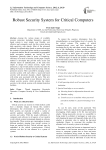
Robust Security System for Critical Computers
Статья научная
Among the various means of available resource protection including biometrics, password based system is most simple, user friendly, cost effective and commonly used, but this system having high sensitivity with attacks. Most of the advanced methods for authentication based on password encrypt the contents of password before storing or transmitting in physical domain. But all conventional cryptographic based encryption methods are having its own limitations, generally either in terms of complexity, efficiency or in terms of security. In this paper a simple method is developed that provide more secure and efficient means of authentication, at the same time simple in design for critical systems. Apart from protection, a step toward perfect security has taken by adding the feature of intruder detection along with the protection system. This is possible by merging various security systems with each other i.e password based security with keystroke dynamic, thumb impression with retina scan associated with the users. This new method is centrally based on user behavior and users related security system, which provides the robust security to the critical systems with intruder detection facilities.
Бесплатно
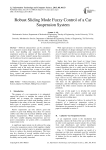
Robust Sliding Mode Fuzzy Control of a Car Suspension System
Статья научная
Different characteristics can be considered in a suspension system design like: ride comfort, body travel, road handling and suspension travel. No suspension system can optimize all these parameters together but a better tradeoff among these parameters can be achieved in active suspension system. Objective of this paper is to establish a robust control technique of the active suspension system for a quarter-car model. The paper describes also the model and controller used in the study and discusses the vehicle response results obtained from a range of road input simulations. A comparison of robust suspension sliding fuzzy control and passive control is shown using MATLAB simulations.
Бесплатно
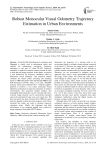
Robust monocular visual odometry trajectory estimation in urban environments
Статья научная
Visual SLAM (Simultaneous Localization and Mapping) is widely used in autonomous robots and vehicles for autonomous navigation. Trajectory estimation is one part of Visual SLAM. Trajectory estimation is needed to estimate camera position in order to align the real image locations. In this paper, we present a new framework for trajectory estimation aided by Monocular Visual Odometry. Our proposed method combines the feature points extracting and matching based on ORB (Oriented FAST and Rotated BRIEF) and PnP (Perspective-n-Point). Thus, it was used a Matlab® dynamic model and an OpenCV/C++ computer graphics platform to perform a very robust monocular Visual Odometry mechanism for trajectory estimation in outdoor environments. Our proposed method displays that meaningful depth estimation can be extracted and frame-to-frame image rotations can be successfully estimated and can be translated in large view even texture-less. The best key-points has been extracted from ORB key point detectors depend on their key-point response value. These extracted key points are used to decrease trajectory estimation errors. Finally, the robustness and high performance of our proposed method were verified on image sequences from public KITTI dataset.
Бесплатно
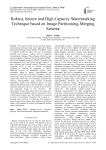
Robust, Secure and High Capacity Watermarking Technique based on Image Partitioning-Merging Scheme
Статья научная
This paper presents secure and high capacity watermarking technique using novel approach of Image Partitioning-Merging Scheme (IPMS). The IPMS is used as reduction method to reduce the size of watermark logically and increases security levels of proposed watermarking technique. The technique effectively uses special properties of Discrete Wavelet Transform (DWT), Fast Walse Hadamrd Transform (FWHT), Singular Value Decomposition (SVD) and proved strongly robust to 14 noise addition and filtering attacks. Fibonacci Lucas Transform (FLT) is used as effective scrambling technique to scramble the watermark to provide additional security in embedding process. Many researchers failed to achieve imperceptibility and robustness under high watermark embedding scenario with strong security provision as these quality parameters conflict each other. The novel technique presented here archives imperceptibility, high capacity watermark embedding, security and robustness against 14 noise addition and filtering attacks. The technique is non-blind and tested with grey scale cover images of size 512x512 and watermark images of size 512x512. The experimental results demonstrate that Lena image gives 75.8446dBs imperceptibility which is measured in terms of Peak signal to noise ratio. The robustness is measured in terms of normalized correlation (NC) equals to 1 showing exact recovery of watermark. The method is found strongly robust against noise addition and filtering attacks with compared to existing watermarking methods under consideration.
Бесплатно
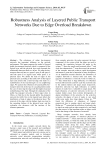
Robustness Analysis of Layered Public Transport Networks Due to Edge Overload Breakdown
Статья научная
The robustness of urban bus-transport networks has important influence on the network performance. This paper proposes the model of layered public bus-transport network which is composed of the logical layer and the physical layer and expounds the relationship between these two layers. We map the bus-transport network into two spaces: space P and space L and take space P as logical layer while space L as physical layer. We define the load of edges in the physical layer according to the traffic flow in the logical layer and assume that a removed edge only leads to a redistribution of the load through it to its neighboring edges. We analysis the robustness of layered public bus-transport networks in the face of cascading failure under the case of removing the edge with the highest load and redistributing of the load. Through the simulation of the public bus-transport networks of three major cities in China, we find that in the layered public bus-transport network the traffic flow in the logical layer affects the distribution of load of edges in the physical layer. The removal of the edge with the highest load may lead to the cascading failures of the physical layer, and the avalanche size decreases with the increase of the tolerance parameter.
Бесплатно

